The Lost City of Z Blu-ray Movie
HomeThe Lost City of Z Blu-ray Movie 
Broad Green Pictures | 2016 | 141 min | Rated PG-13 | Jul 11, 2017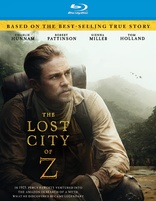
Movie rating
7.2 | / 10 |
Blu-ray rating
| Users | 4.0 | |
| Reviewer | 4.0 | |
| Overall | 4.0 |
Overview
The Lost City of Z (2016)
Based on David Grann's best-selling book of the same name, The Lost City of Z is the true-life drama which centers on British explorer Col. Percival Fawcett, who disappeared while searching for a mysterious city in the Amazon in the 1920s.
Starring: Charlie Hunnam, Tom Holland (X), Robert Pattinson, Sienna Miller, Angus MacfadyenDirector: James Gray (I)
| Biography | Uncertain |
| Period | Uncertain |
| Adventure | Uncertain |
| Action | Uncertain |
Specifications
Video
Video codec: MPEG-4 AVC
Video resolution: 1080p
Aspect ratio: 2.39:1
Original aspect ratio: 2.39:1
Audio
English: DTS-HD Master Audio 5.1 (48kHz, 24-bit)
Spanish: DTS 5.1 (48kHz, 24-bit)
BDInfo
Subtitles
English SDH, Spanish
Discs
Blu-ray Disc
Single disc (1 BD)
Playback
Region A (locked)
Review
Rating summary
| Movie | 4.5 | |
| Video | 4.5 | |
| Audio | 5.0 | |
| Extras | 2.0 | |
| Overall | 4.0 |
The Lost City of Z Blu-ray Movie Review
Reviewed by Dr. Stephen Larson July 16, 2017Although The Lost City of Z is the first of James Gray's six features to be set outside New York, it's actually his third period piece, following the late eighties Brooklyn crime drama We Own the Night (2007) and 1920s Ellis Island as it's represented in The Immigrant (2013). Geographically, Lost City's Amazon is far removed from the immigrant communities Gray portrayed in his films set in the upper East. Stylistically, however, Gray's latest displays the same precise use of light and dark shadows as his other work, only this time Gray relied primarily on firelight for evening shots. Lost City was initially developed back in 2010 when executive producer Brad Pitt sent Gray a copy of David Grann's 2009 nonfiction book, The Lost City of Z: A Tale of Deadly Obsession in the Amazon. Gray read it quickly and was immediately captivated by the journey of British explorer Lieut. Col. Percy Fawcett to find an ancient civilization. Pitt was going to star as Fawcett but after ongoing conversations with Gray, the two decided it should be played by a Brit. Benedict Cumberbatch tentatively agreed to play the main role but complications arose when his wife got pregnant and production was ready to start. The role eventually went to New Castle native Charlie Hunnam (Pacific Rim, Sons of Anarchy).
The movie begins around the turn of the century with Fawcett leading a British Army Barracks across the Irish countryside in Cork for a game hunt. Here Gray foreshadows the dichotomous relationship between civility and cruelty that will ensue between Western European explorers and the indigenous peoples whose land and customs will be exploited. The British soldiers are dressed in freshly starched fatigues and appear stout if not regal on horseback. Although the shots of landscapes first seem beautiful, Gray turns the milieu into a rough and rugged terrain. The soldiers gallop their way briskly to their prey, firing on the elk. Upon returning home, Percy and his loving wife, Nina (Sienna Miller), attend a lavish gala for the archduke featuring dignitaries and statesmen. Although the Fawcetts are fairly well off, Percy yearns to move up the class ladder at least one big step. Fawcett gets his chance to gain more fame but in an unexpected way. He is invited to the the Royal Geographical Society where its President, Sir George Goldie (Ian McDiarmid), gives him the assignment of traveling to South America to discover the lost city of Zed or "Z" where an ancient tribe and gold may lie. Gray compresses Fawcett's eight expeditions into three to accommodate the film's 141-minute run time and three-act structure. Aboard the S.S. Panama vessel on the Atlantic, Fawcett meets bespectacled and bearded Henry Costin (Robert Pattinson), who becomes his aide-de-camp and confidant. Along with guides and porters, Fawcett and Costin make their first trip into Amazonia where they are ambushed on a boat by a spate of arrows fired on land by a local tribe.
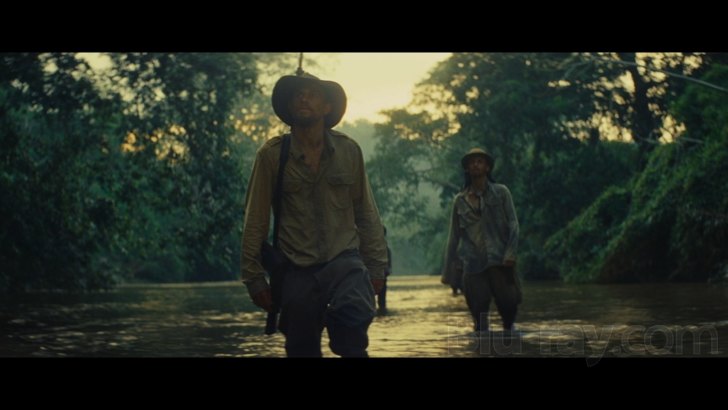
Percy Fawcett and his followers search for the lost city.
The Lost City of Z is a sumptuously photographed epic that was shot on location in Belfast, Sierra Nevada de Santa Marta, and Rio Don Diego (the latter two set in the jungles and rivers of Magdalena, Colombia.) Viewers expecting a more conventional story in which the hero reaps material glory from his quest will be disappointed. The film is essentially about Fawcett's fledgling interest to understand "the other world" and its inhabitants. While the real-life Fawcett was a racist, he was not without sympathy for the natives and sought to learn about their ways of life. Gray shows how Fawcett's growing obsession with locating the lost city takes a toll on his family. Nina scolds him for not asking her enough about how she's doing or what she's been up to. When he comes off the ship, Fawcett is confronted by his young boy Jack who asks his father if he knows that this is indeed his son. As Jack grows older, he rebukes his dad for not being there for Nina and her children. Percy Fawcett acquires a sobering outlook on life when he goes off to fight in the Great War and the cataclysmic Battle of the Somme. Using vast historical research he consulted at the Imperial War Museums in London as well as Stanley Kubrick's Paths of Glory as a visual template, Gray stages harrowing scenes of soldiers in the trenches and their protracted attempts to advance through enemy lines. Rather than use a Steadicam for the handheld work, Gray employs a dolly to depict the soliders' progression and movements. Instead of donning his gas mask as Costin tells him, Fawcett fights on and is exposed to chlorine gas, which renders him blind for a year. Seeing his father in a most feeble position on a hospital bed, Jack Fawcett (now a young man and played by Tom Holland) knows that his dad cannot venture out anytime soon and realizes it's time to become closer to him. Jack starts acting likes his old man, shooting rabbits with his rifle and developing a keen curiosity for the lost city. Gray uses the third act as an act of atonement for Percy. He and Jack will travel to the Amazon together along a path that will serve as a road of redemption for father and son.
The Lost City of Z Blu-ray Movie, Video Quality 

The Lost City of Z arrives on US Blu-ray on this AVC-encoded BD-50 courtesy of Broad Green Pictures. Gray's sixth movie is presented in its original theatrical aspect ratio of 2.39:1. Lost City was shot on 35mm using the Anamorphic format. You'll notice in several of the screenshots (most notably #s 2, 4, 7, and 13) the presence of grain but this is by intention. As Gray explains in his commentary track on this disc: "I thought that the grain of the film itself―the way that the image is made up of these little dots that seem to buzz―it's almost alive in and of itself. It's such an organic process as opposed to the digital grid....what I find useful in film is that it conjures a bit of the melancholy....film preserves the irretrievability of the past better than digital does." According to American Cinematographer writer Iain Marcks, director of photography Darius Khondji and Gray employed the Kodak Vision3 500T 5219 stock for most of the production. For the jungle scenes, Khondji says he underexposed some scenes but overexposed others so grain could really accumulate and form a cluster. I sat relatively close to my tube as I watched Lost City but the grain didn't distract me. Viewers with displays measuring between 75" and 120" will probably notice it more but I don't think it'll be a hindrance to enjoying the film.
French painter Claude Lorrain was an aesthetic influence on the film's design. Khondji said he purposely designed mythical images of skies that Lorrain may have painted that are filled with gold, red, and blue (or a combination of them). See capture #s 15, 18, and 19 as well as the film itself for other illustrative examples. Khondji and Gray color-corrected in daylight with a Tiffen 812 Warming filter. Other sequences were captured on Vision3 200T 5213 and 50D 5203. As Gray notes on the alternate sound track, Khondji and second unit director Dave Roddham put smoke in strategic places in the background sometimes to produce a mist effect that helped diffuse some of the sunlight. (See Screenshot #s 1 and 5). In more technical terms, Khondji chose Arri's VariCon because, to quote Marcks, "it uses a variable color and intensity light source to illuminate a glass filter that fogs the image, raising detail and sensitivity in the shadow areas without affecting the midrange or highlights." Khondji also incorporated the VariCon for day and night interiors to cool the shadows (see #14). For the war sequence, colors were desaturated in favor of a preponderance of charcoal-like gray (see the top half of #9).
The Lost City of Z doesn't include a lot of close-ups but when they're deployed, Khondji said he wanted to frame them using a wide-angle lens. But to prevent faces from getting elongated, Khondji asked an optical engineering and lens strategy expert to give him a 50mm C Series prime to optimize for close focus.
There are no source flaws or compression artifacts on this transfer. Broad Green has provided twenty chapter selections for the main feature.
The Lost City of Z Blu-ray Movie, Audio Quality 
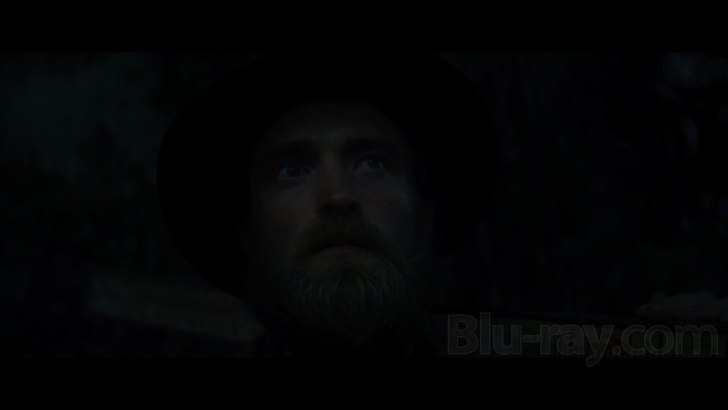
Broad Green supplies an English DTS-HD Master Audio 5.1 for the film's main sound track and a dubbed Spanish DTS. Lost City contains mostly English-speaking dialogue but when spoken words are in Spanish, Portuguese, and German, non-removal English subtitles are displayed in a sans serif font near the bottom of the composition (see #20). I also watched the film with the optional English SDH enabled and the captions accurately reproduce what is said with the character's name denoted within brackets before each utterance. The whole ambiance of the jungle is given full life on the surround channels, including insect and animal noises which are completely amplified. Gray includes a ton of classical music on the sound track, including pieces by Bach, Beethoven, Mozart, Stravinsky, and Verdi. A highlight is Maurice Ravel's Daphnis et Chloé Suite No. 2: Lever du jour, which just soars. Not lost is Christopher Spelman's original score, which captures the Amazon's sense of awe and wonder.
The Lost City of Z Blu-ray Movie, Special Features and Extras 
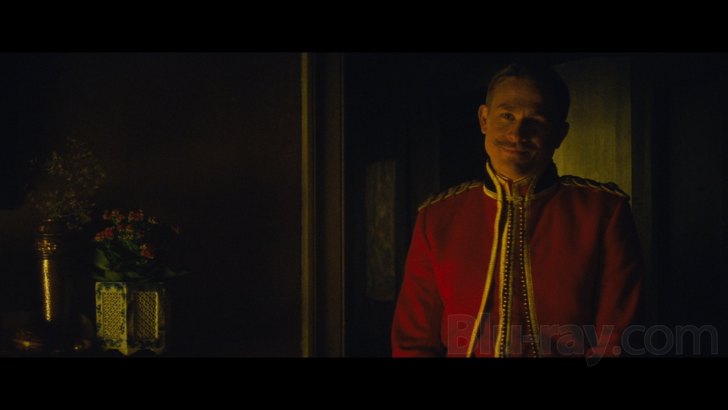
- Feature Film Commentary by Director James Gray - the always articulate Gray delivers a very chatty discussion of Lost City, including the immense logistical problems the production posed. There are only a few very short lulls (including at the two-hour mark) but Gray remains present till the middle of the end credits. In English, not subtitled.
- Adventure in the Jungle (2:21, 1080p) - a mini-featurette with very short interviews with director James Gray, author David Grann as well as actors Charlie Hunnam, Sienna Miller, Robert Pattinson, and Tom Holland. Shows some on-location footage. In English, not subtitled.
- From Novel to Screen (3:10, 1080p) - a promotional featurette with more interview snippets with Grann, Gray, Hunnam, Pattinson, and Holland. The remarks are intercut with clips from the film. In English, not subtitled.
- Expedition Journal - designed like one of Percy Fawcett's own scrapbooks, this is basically a photo gallery made up of two sections: "Exploring the Journey" and "Creating the Journey." The former contains twenty notebook pages of stills from the film. You can click on an image and make it bigger but unfortunately, they're not full-size to fill the screen. The latter is comprised of eighteen pages with photos taken on the set.
- Preview (2:20, 1080p) - an original theatrical trailer for The Salesman that loads following the disc's insertion and isn't accessible from the menu. In Farsi, with English subtitles.
The Lost City of Z Blu-ray Movie, Overall Score and Recommendation 
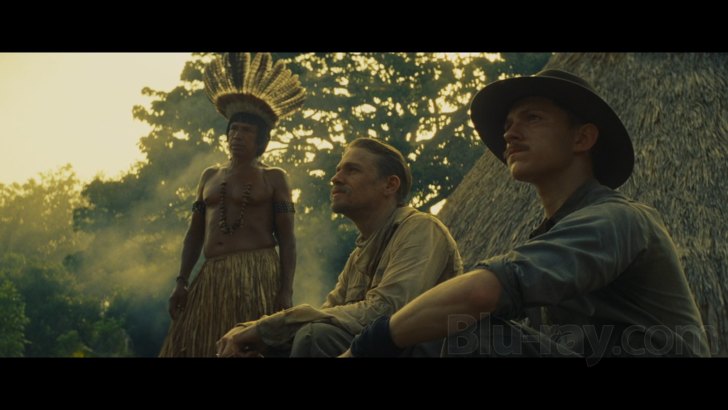
The Lost City of Z is likely the most difficult film James Gray has yet to make and the New York filmmaker amply demonstrates that he is more than capable of producing movies other than crime thrillers and romantic dramas. Broad Green Pictures' transfer faithfully replicates the way I saw the picture in the cinema. The real standout is the lossless audio, which unrestrainedly recreates the way the jungles are supposed to sound in Colombia. Gray's commentary is essential listening but the rest of the extras are extremely brief featurettes. One hopes that there will be a deluxe special edition someday but this BD still comes HIGHLY RECOMMENDED.
Similar titles
Similar titles you might also like

The Man Who Knew Infinity
2015

The Salt of the Earth
Le Sel de la Terre
2014

Only the Brave
2017

Wild
2014

Green Book 4K
2018

Fair Game
2010

True History of the Kelly Gang
2019

The Front Runner
2018

Genius
2016

Rosewater
2014

Gorillas in the Mist: The Adventure of Dian Fossey
1988

All Is True
2018

Lovelace
2013

A Private War
2018

The Lady in the Van
2015

Breathe
2017

Jimi: All Is by My Side
2013

Sully 4K
2016

Megan Leavey
2017

Vice
2018

